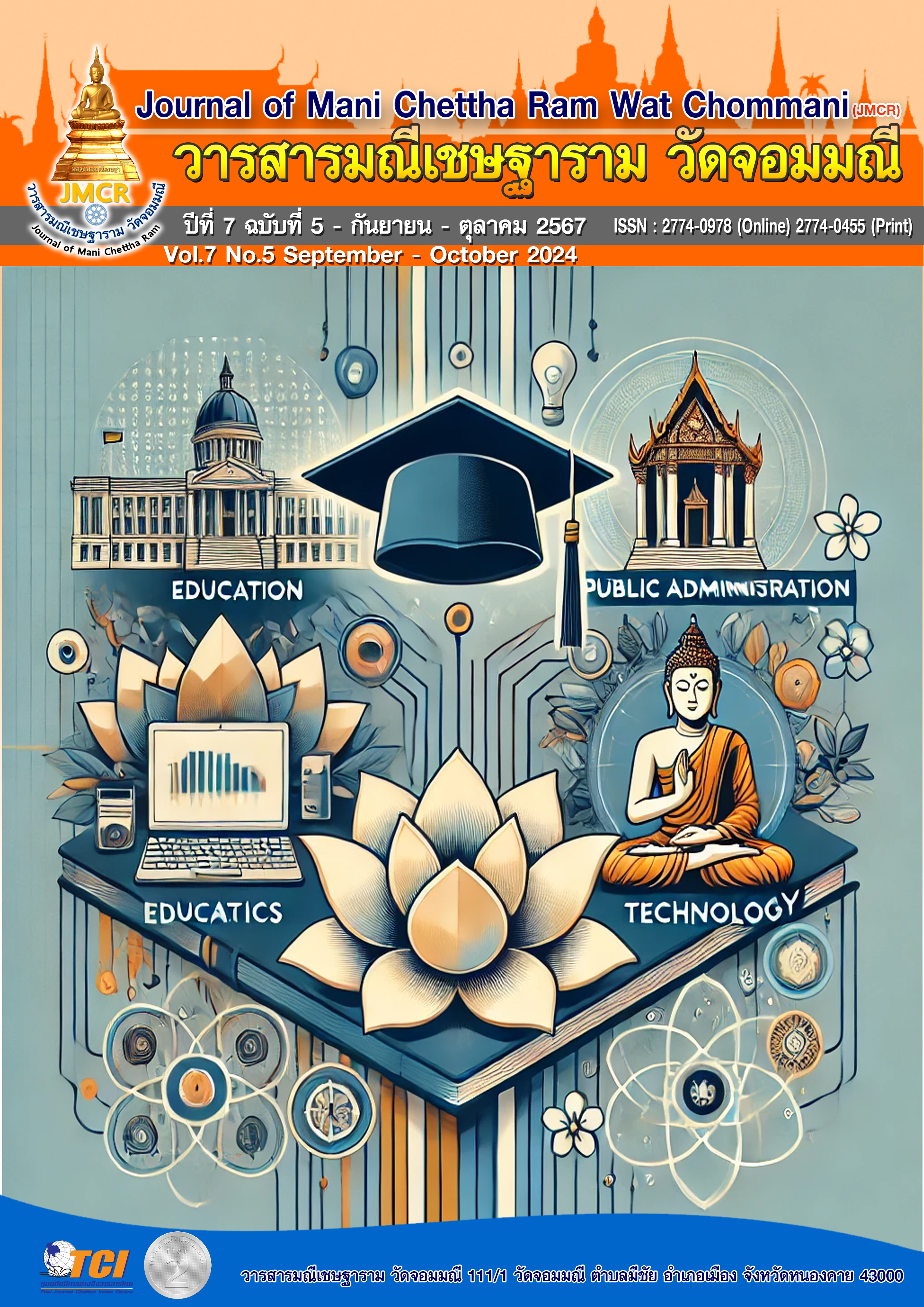THE GUIDELINES FOR PERSONNEL MANAGEMENT ACCORDING TO THE BRAHMA VIHARA DHAMMA OF SCHOOL ADMINISTRATORS IN RON PHIBUN – CHULABHORN CAMPUS UNDER THE OFFICE OF SECONDARY EDUCATION AREA NAKHON SI THAMMARAT
Keywords:
Administration, Personnel Work, Principles of Brahma Vihara Dhamma, Executive,Abstract
The objectives of this article are as follows: 1) To study the state of personnel management according to the principles of Brahma Vihara Dhamma among educational institution administrators. In the Ron Phibun - Chulabhorn Campus, under the Nakhon Si Thammarat Secondary Educational Service Area Office 2) to study problems and obstacles in personnel management according to the principles of Brahmawihan Dhamma of educational institution administrators. In the Ron Phibun - Chulabhorn Campus, under the Nakhon Si Thammarat Secondary Educational Service Area Office 3) to study guidelines for developing personnel management according to the principles of Brahmawihan Dhamma for educational institution administrators. In the Ron Phibun - Chulabhorn United Campus, under the Nakhon Si Thammarat Secondary Educational Service Area Office, the population includes teachers in the Ron Phibun - Chulabhorn United Campus, under the Nakhon Si Thammarat Secondary Educational Service Area Office, in the academic year 2023, numbering 203 people. Sample sample using Krejcic and Morgan tables. The sample group was 136 people. The research instrument was a questionnaire. Statistics used in data analysis included frequency distribution, percentage, mean, standard deviation.
The results showed that
- Conditions of human resource management according to the principles of Brahmaviharndhamma of administrators of educational institutions in the Ron Phibun - Chulabhorn co-educational campus under the Nakhon Si Thammarat Secondary Educational Service Area Office. Overall, it is at the highest level.
- Conditions of problems, obstacles, and guidelines for human resource management according to the principles of Brahma Vihara Dhamma of educational institution administrators. It was found that educational institution administrators should pay attention to, care for, and train personnel. They should not neglect them. Neglect until causing damage There should be compassion for personnel who are experiencing mental distress. When you go to consult about problems, it brings happiness. and should be kind and teach in order to create unity in the management of the school
- Guidelines for developing human resource management according to the principles of Brahmavihara Dhamma for school administrators found that school administrators should explain various information politely. Always show friendliness. and should extend love to the people in the organization equally It will make personnel have faith in the executives, whatever policy they come up with. Personnel who receive love and kindness will work together to realize their dreams to the fullest. Let's join together and help each other.
References
กนก วงษ์ตระหง่าน. (2564). ครูลาออกทนภาระงานเอกสารไม่ไหวสะท้อนระบบการศึกษาล้มเหลว. เรียกใช้เมื่อ 16 ธันวาคม 2566 จากhttps://www.thansettakij.com/politics/503355.
กัณฑ์พงษ์ นามเสน่ห์. (2559). การปรับใช้หลักพรหมวิหาร 4 กับการบริหารบุคลากร. Journal of Roi Kaensarn Academi, 1(2), 38.
กิตติยา สุขเกษม. (2565). แนวทางการพัฒนาภาวะผู้นำแบบมีส่วนร่วมตามหลักพรหมวิหารธรรมของผู้บริหารสถานศึกษา ในกลุ่มโรงเรียนจตุรมิตร อำเภอลาดยาว จังหวัดนครสวรรค์ สำนักงานเขตพื้นที่การศึกษาประถมศึกษานครสวรรค์ เขต 2. วารสารวิชาการ, 5 (2), 77.
พรนภา ชำนินอก. (2564). การใช้หลักพรหมวิหาร 4 ในการบริหารโรงเรียน ศูนย์เครือข่ายพัฒนาคุณภาพการบริหารการศึกษายางตลาด 3 จังหวัดกาฬสินธุ์. ใน สารนิพนธ์ (ศษ.ม.) การบริหารการศึกษา. มหาวิทยาลัยมหามกุฏราชวิทยาลัย.
พระทวีศักดิ์ คุตฺตสีโล (ไวชมภู). (2560). การบริหารโดยใช้หลักพรหมวิหาร 4 ของผู้บริหารโรงเรียนปริยัติธรรม ในจังหวัดเลย. ใน วิทยานิพนธ์ (ศษ.ม). สาขาวิชาการบริหารการศึกษา. มหาวิทยาลัยมหามกุฏราชวิทยาลัย.
พระพรหมคุณาภรณ์ (ป.อ.ปยุตฺโต). (2548). พจนานุกรมพุทธศาสตรฉบับประมวลธรรม. พิมพ์ครั้งที่ 13. กรุงเทพมหานคร: บริษัท เอส.อาร์. พริ้นดิ้ง แมส โปรดักส์จำกัด.
พระมหาชัยวัฒน์ จตฺตมโล (พรหมสนธิ). (2560). รูปแบบการบริหารงานบุคคลตามหลักพุทธบริหารการศึกษาของโรงเรียนพระปริยัติธรรม แผนกสามัญศึกษา กลุ่มที่ 4. ใน พุทธศาสตรดุษฎีบัณฑิต พธ.ค. (พุทธบริหารการศึกษา). มหาวิทยาลัยมหาจุฬาลงกรณราชวิทยาลัย.
พระสมุห์สมนึก สมณธมฺโม (อุทัยแสงไพศาล). (2561). แนวทางการพัฒนาคุณลักษณะของครูตามหลักพรหมวิหาร 4 ในโรงเรียนมัธยมศึกษา จังหวัดปทุมธานี. ใน วิทยานิพนธ์ปริญญาพุทธศาสตรมหาบัณฑิต. สาขาวิชาพุทธบริหารการศึกษา. มหาวิทยาลัยมหาจุฬาลงกรณราชวิทยาลัย.
ภรณี ลัคนาภิเศรษฐ์ และธนิสรา สุทธานันต์. (2564). ไม่ใช่เรื่องผิด ถ้าครูจะบอกว่า วันนี้ฉันรู้สึกไม่โอเค. เรียกใช้เมื่อ16 ธันวาคม 2566 จาก https://www.educathai.com/knowledge/articles/34.
มูนา จารง. (2560). การบริหารงานวิชาการของผู้บริหารสถานศึกษาตามทัศนะครูผู้สอนในศูนย์เครือข่ายตลิ่งชัน สังกัดสำนักงานเขตพื้นที่การศึกษาประถมศึกษายะลา เขต 2. สาขาวิชาการบริหารการศึกษา. บัณฑิตวิทยาลัย. มหาวิทยาลัยราชภัฏยะลาสาขาวิชาการบริหารการศึกษา. มหาวิทยาลัยราชภัฏยะลา
ยุทธศาสตร์ชาติ (พ.ศ. 2561 - 2580). (2561). ราชกิจจานุเบกษา. เล่ม 135 ตอนที่ 82 ก.
สำนักงานเลขาธิการสภาการศึกษา. (2560). แผนการศึกษาแห่งชาติ พ.ศ. 2560 - 2579. กรุงเทพมหานคร: บริษัท พริกหวานกราฟฟิค จำกัด.
สุรศักดิ์ อุดเมืองเพีย (2559). แรงจูงใจในการทำงาน : ทฤษฎีและการประยุกต์ใช้.มหาวิทยาลัยมหามกุฏราชวิทยาลัย วิทยาเขตอีสาน. วารสารอุบลปริทรรศน์, 5 (1), 424.
อุทิศ การเพียร. (2562). การบริหารบุคลากรตามหลักพรหมวิหาร 4 ในทัศนะของ บุคลากรตำแหน่งปฏิบัติ การวิชาชีพและบริหารทั่วไป มหาวิทยาลัยมหาจุฬาลงกรณราชวิทยาลัย. ใน วิทยานิพนธ์พุทธศาสตรมหาบัณฑิต. มหาวิทยาลัยมหาจุฬาลงกรณราชวิทยาลัย.



